If we were to sum up Japanese interior design in one word, it would be – zen. Steeped in thousands of years of tradition, this ancient style, known as “Kanso”, is not only calming but a cultural representation of the Japanese way of life. And with many years of experience, trial and error, this traditional home aesthetic has accumulated some solid and simple principles which we should all follow when it comes to our home’s interior.
In this blog, we will explore the top 7 Japanese interior design principles found in Japanese houses. And with the help of interior design experts, we will explain how you can make these work in your own home. Whether you live in a city apartment, country cottage or a 1970s build, everyone can benefit from these Japanese style tips…
1) What is a Japanese style room? = Multi-functional and flexible
One of the main reasons why people are in love with Japanese interior design is that it is a huge space-enhancer. And who doesn’t love to make their home feel bigger and airier? This is because many traditional Japanese houses embrace open-plan living areas.
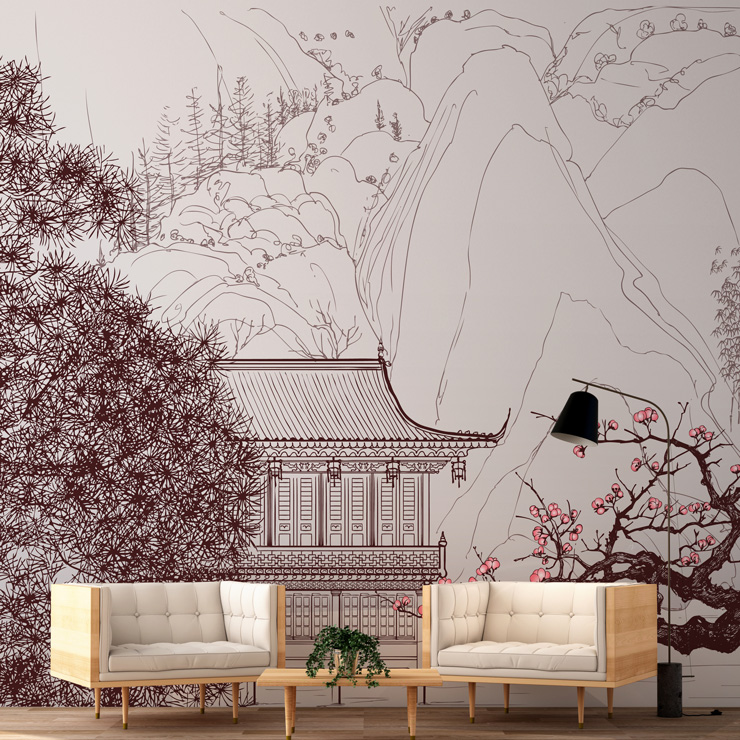
Mural in photo: Delicate Chinese Landscape
We adore the openness of the lounge above. Not forgetting the gorgeous and traditional Japanese cherry blossom wallpaper.
Jen Stark, Founder of Happy DIY Home, explains the rise in popularity for flexible rooms.
'With the current need to downsize or expand homes to allow elderly parents to be part of the household, multi-functional rooms will rise in popularity. A large living space can function as a dining area, lounge and bedroom with a futon being stored away in a cupboard during the day.'
This popular, space-enhancing style is a great option if you are city dweller who understands the desirability of floor space! By combining your kitchen, dining area and lounge into one large space will not only give you extra room to play with but create a great sociable space for you to host in.
2) Japanese interior design is in-tune with nature and natural light
In recent months, the need to become more in-tune with nature has vastly grown as we find ourselves stuck indoors more often than we would like. The rise of popular cultures, such as the cottagecore trend, are bringing the outdoors in and making us feel less claustrophobic in our own homes. However, cottagecore is maximalist and not popular amongst those who love more of a clean, minimalist look. The answer? Japanese interior design!
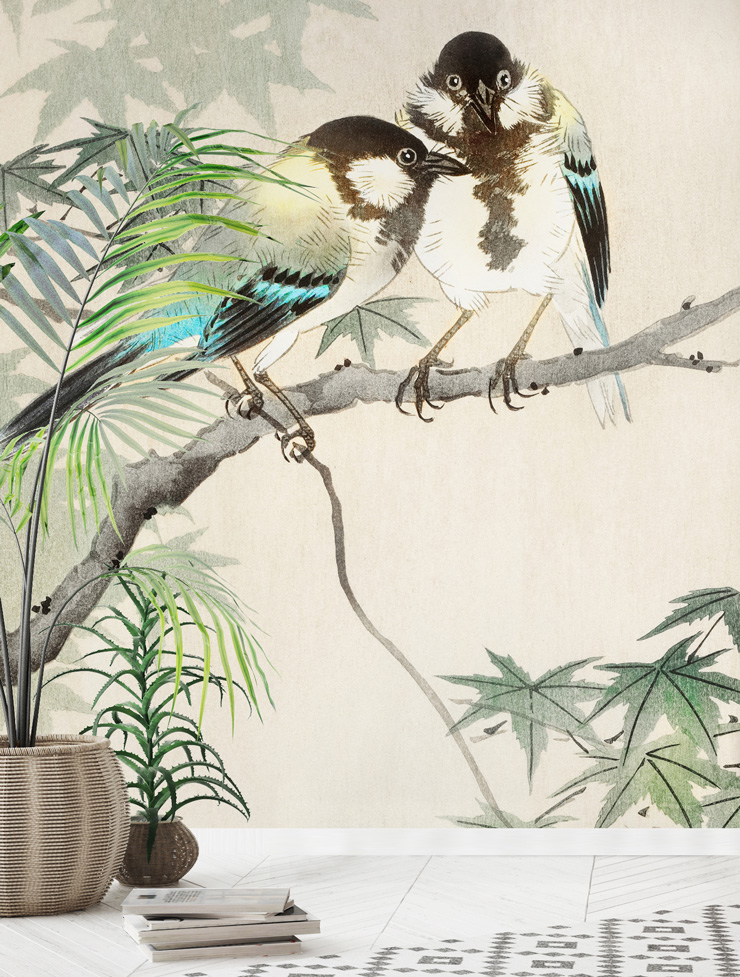
Mural in photo: Great Tits on Maple Branch
This ancient, oriental style focusses greatly on infusing nature and light within the Japanese home. This makes it a popular choice for nature lovers. Helen White, Lead Designer and Co-Founder of Houseof.com, explains an ancient Japanese philosophy which is integral to connecting people with nature.
'The “shizen” philosophy is a principle that recognises the harmony between people and nature and is core to many Japanese furniture design methods which often use bamboo and light woods. Owing to this philosophy, many designers also use nature to honour the world that they live in.'
The ways to integrate nature and light into the Japanese home are endless...
Large windows for natural light
Firstly, large windows and sliding doors are crucial to allow natural light to flood into the room.
'Choose large sheet windows to maximise light and connection with the outdoors along with natural fibre carpets and furniture.' – Jen Stark (Founder of Happy DIY Home)
One of the main reasons why many of the Japanese opt for sheeted window shutters is because they highly value privacy. These paper screens or “Shoji” allow the light in but keep prying eyes out.
Los Angeles Interior Designer, John Linden, explains more.
'Finally, to get the best of the outside in your home, add a large window or sliding glass door. This gives you a view of the natural space beyond your interior. To get the best Japanese style sliding screen or door, use a glass panel in a wooden frame.'
Natural and sustainable fibres
All Japanese homes mirror the outside world and often embrace sustainable materials mixed with natural fibres.
'Wood, bamboo, and rattan are materials often used for different interior features. Insets, walls, frames, lofts and screen grids are usually made of natural wood such as cypress and red pine. Wood adds texture, serenity and refinement to your space.' – John Liden (Los Angeles Interior Designer)
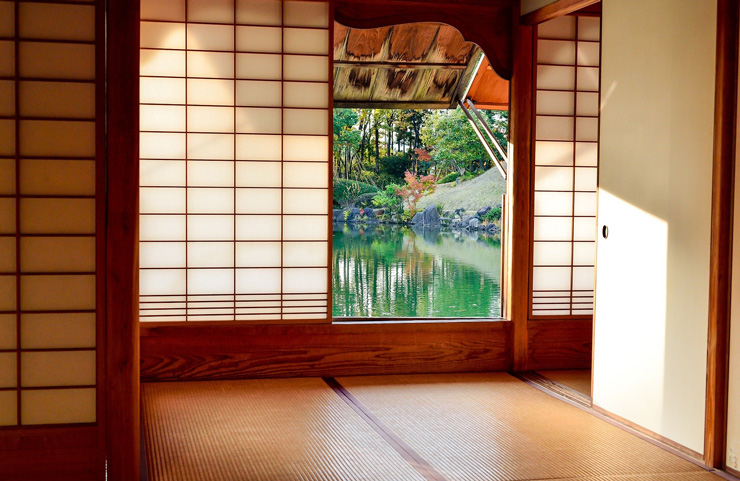
Interior Designer, Amira Johnson, definitely knows a thing or two about Japanese interior design and its love for nature.
'Flooring is either wood or grey stone tile and most walls are replaced with screens that are covered in opaque paper. This design ends up in a natural colour palette that's very neutral.'
Plants and water features
One of the most common ways to integrate the outside into the home is to use plants. But when it comes to achieving a Japanese look, stick to plants that have an oriental look about them.
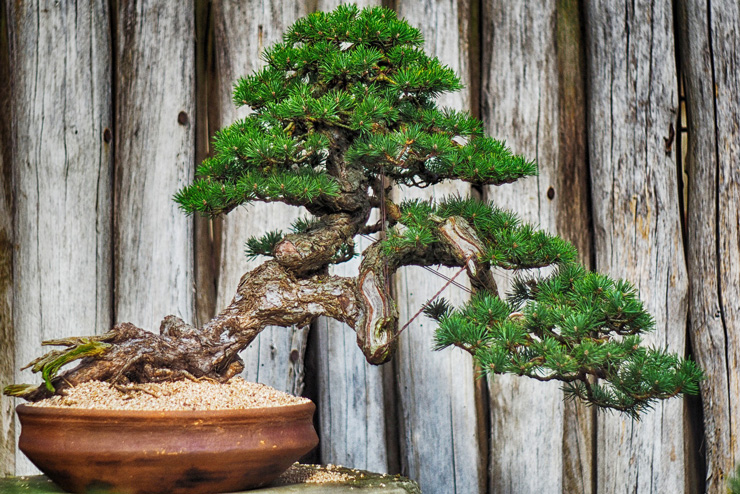
'Plants are also a great way to add nature to your Japanese style interior. A bonsai tree is a common feature in a Japanese inspired interior. You may also consider a variety of rooted green home plants. Dumbcanes, aloe vera, palms and orchids are plants you may use. The plants may also be potted or hanging plants, which adds sleekness.' – John Liden (Los Angeles Interior Designer)
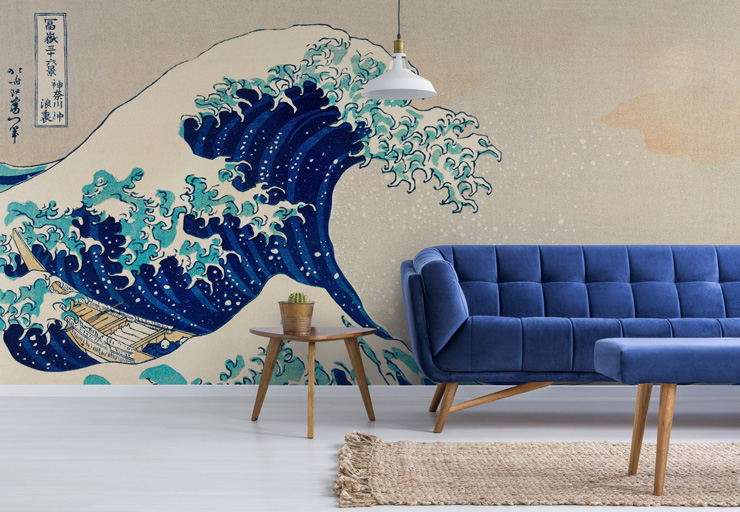
Mural in photo: Kanazawa Oki Nami Ura
Bringing water features into the home is always a good idea for achieving a zen space in your home. If they look so great outdoors, why not embrace them inside as well? As well as physical water features, a water-themed, oriental wall mural is another way to add a water element into the home.
'Water features are also a core component of this design philosophy and can make a fantastic grounding element for a home meditation practice.' - Helen White (Lead Designer and Co-Founder of Houseof)
3) Minimalism is crucial in Japanese interior design
Current Japanese design is recognised as one of the best versions of minimalism today thanks to its focus on “Shibui”: simple beauty, detail and a love for natural materials.
'The Japanese perceive the basest form of simplicity as a form of luxury. Contemporary, uncomplicated furniture with clean lines from this part of the world often has extremely intricate engineering with complex joinery. You can easily integrate this look into your home by using simple furniture that eschews gaudy, ornate detailing in favour of form and function.' - Helen White (Lead Designer and Co-Founder of Houseof)
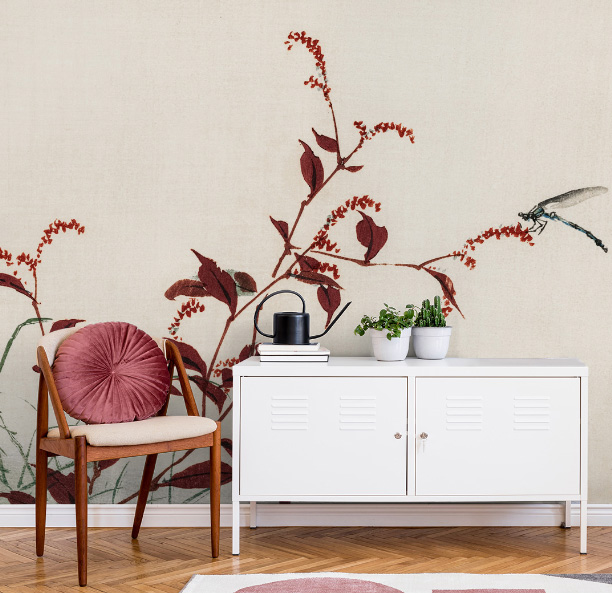
Mural in photo: Dragonfly wallpaper
De-cluttering goes hand in hand with a Japanese modern house. We only need to follow the famous Japanese Organising Consultant Marie Kondo to know that! Joe Flanagan is a fashion, entertainment and culture Blogger who lived in Japan for two years. He has a huge passion for Japanese culture and understands minimalism down to a tee.
'One of the most important principles of Japanese interior design is that less is more. Austerity, minimalism, appreciation of heirlooms and traditions survive in a unique amalgam that adapts technology and modernism so that they fit into an already established aesthetic and not the other way around.'
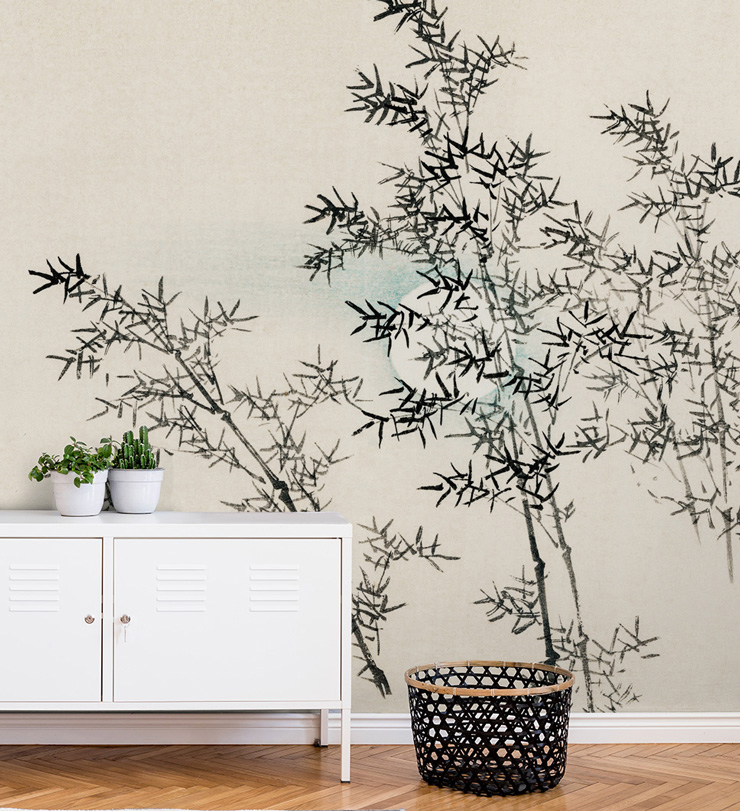
Mural in photo: Bamboo wall mural
Japanese minimalism is aesthetic, but more importantly, functional. Director of the vintage décor store Scaramanga, Carl Morenikeji explains how the simplicity of Japanese design has influenced many other styles.
'Many styles are influenced by the minimal aesthetic of Japanese interiors. So, it’s no surprise that the style should become the forefront in 2020. Especially given there’s been so much soothing minimalism. To us, Japanese interiors are all about beautifully crafted functional pieces of furniture made from natural materials with simple forms like origami fold style patterns mixed with organic decorative shapes and symbols.'
4) How can I embrace Japanese style? = Choose neutral colours
In close connection to nature, the most common colour schemes found in Japanese interior design are highly influenced by the outdoors.
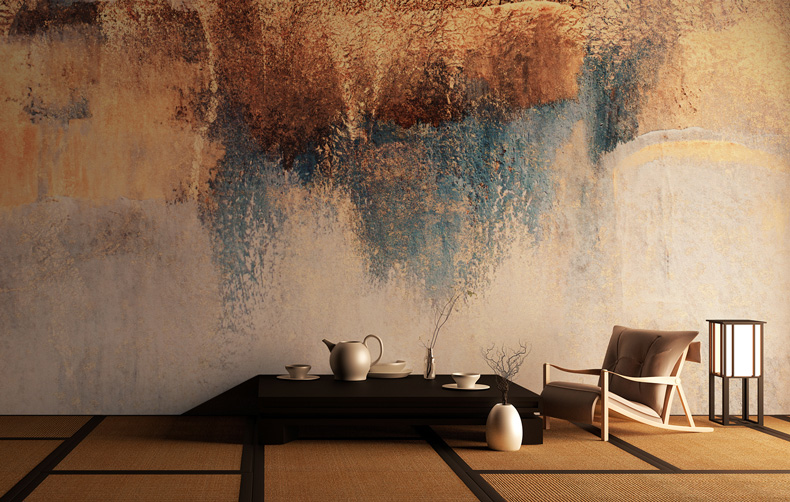
Mural in photo: Storm Ahead
'Simplicity is essential when choosing your colour palette. Look outside your windows to check what natural colour elements you can incorporate in your home today… With the natural beauty of the outside world, Japanese homes typically contain simple colours from nature. Predominant colours are derived from the browns of wooden elements, and also the greens of plants.' - Amira Johnson (Interior Designer)
More importantly, when it comes to a Japanese house interior, focus on simplicity and avoid maximalism at all costs. Keep it simple and focused.
'The colour scheme should be neutral or straightforward. Wooden brown and green from plants are popular alongside the grey of stone tiles.' – John Liden (Los Angeles Interior Designer)
5) Japandi – a beautiful blend of two cultures
One aspect of Japanese interior design that we love is Japandi – a mix of Japanese and Scandinavian design. Both are beautifully minimalist, stylish and homely so a marriage of both is a match made in heaven!
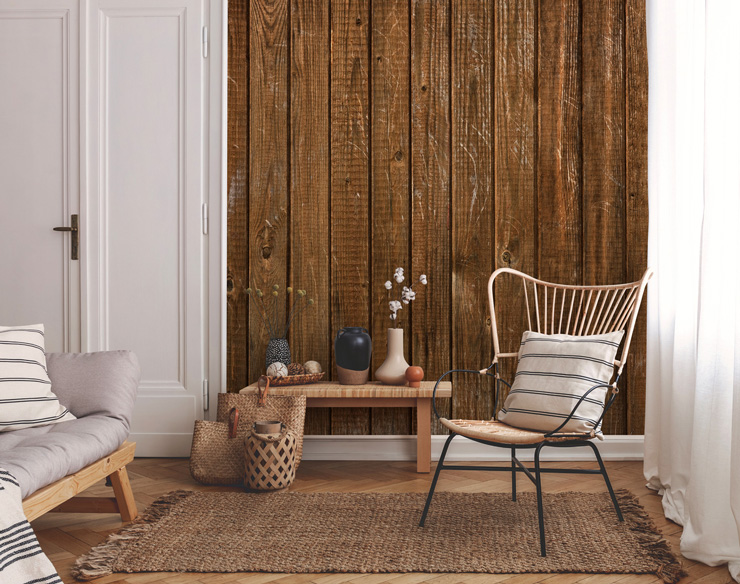
Mural in photo: Wood Texture Natural Finish
Here are some tips for achieving the Japandi look from Interior Designer Amira Johnson.
'Characterised by a love for all things minimalist and natural, Scandinavian emphasis on function over form and respect for the beauty of the imperfect inherited from Japanese design, Japandi will probably continue the trend for years to come… You can spice it up with a couple of handpicked accessories originating from Scandinavian and Japanese design, like authentic tatami mats, Oriental tapestries, woollen throws, ceramic pots and animal hides...
Dark leather upholstery will also check out the range in a Japandi room if used within moderation. So will vintage and mid-century modern pieces that can be utilised to define the backdrop for creative design experiments with colours, textures, and materials.'
6) Classic Japanese items to add authentic culture into the home
If you want to go big and embrace authentic Japanese décor into your home, then you must include the following items in your interior design.
Replace doors with norens and carpets with tatami mats
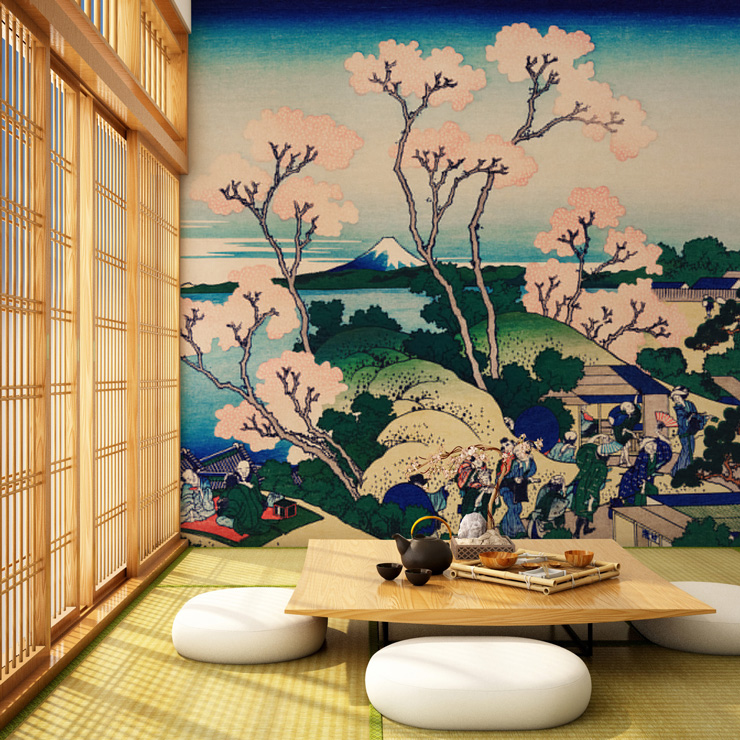
Mural in photo: Goten Yama Hill Shinagawa
'An easy way to incorporate Japanese style elements into a home is by replacing a wooden door by a Noren. A Noren (暖簾) is a fabric divider that is traditionally hung between rooms. It can be hung on walls, in doorways, or in windows. Usually, they have one or more vertical slits cut from the bottom to almost the top of the fabric that allows passage for a person and half viewing of the room beyond.... If you want another great option, go for shoji screen partition dividers for the rooms. There is nothing that says Japan as these paper moving walls.' - Joe Flanagan (Interiors Blogger)
Another popular option for achieving the ideal Japanese living room style is to use “Tatami” mats. Not just for practising martial arts on, tatami mats are a popular choice for homes. Again, they can be folded away when not needed and are made from sustainable natural materials such as woven soft rush straw.
Futons, kotatsus and zaisus oh my!
A "Futon" bed has a padded mattress called a "Shikibuton", a quilt called a "Kakebuton" and a pillow filled with beans called a "Makura". Futons are easily rolled up off the floor when not needed – perfect for decluttering the room after bedtime!
'Another great option is to go for a raised platform bed that mimics a futon. You can achieve the look placing your bed on a raised wooden platform with a little ladder on the side.' - Joe Flanagan (Interiors Blogger)
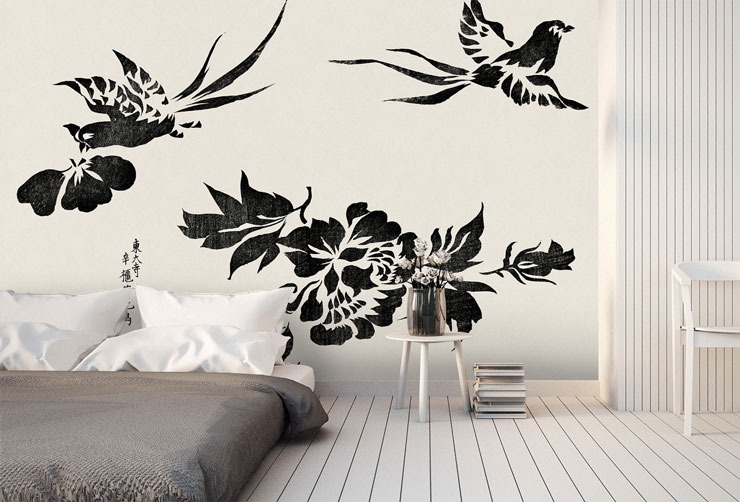
Mural in photo: Woodblock Print of Pheasants
If you love lying on the sofa with a blanket in the winter, then you NEED a "Kotatsu". A kotatsu is a stable piece of furniture in a Japan style living room. A kotatsu has the structure of a low wooden table frame which is covered with a futon or heavy blanket and topped with a tabletop. Underneath is a charcoal brazier or an electric heater built into the table. Just imagine lying underneath all that warmth in the middle of winter. Bliss!
A great addition to a kotatsu table are "Zaisu" chairs as can be seen in the image above. These are often just like regular chairs with a padded cushion and back but they have no legs! They are great for sitting on and cosying under a heated kotatsu table.
7) Wabi Sabi – appreciating the beauty of imperfection
One important factor of Japanese interior design is Wabi Sabi. Rather than striving for utter perfection, this Japanese principle is unsophisticated and rustic in a beautiful way. Whether through a choice of hand-crafted ornaments or a room complete with Wabi Sabi interior, everyone can embrace imperfect beauty.
'Best of all vintage Japanese interiors mean Wabi Sabi, the Japanese art of appreciating the beauty in the naturally imperfect world. It is an ancient aesthetic philosophy rooted in Zen Buddhism, particularly the tea ceremony, a ritual of purity and simplicity in which Zen Masters prized bowls that were handmade and irregularly shaped, with uneven glaze and tiny cracks.' – Carl Morenikeji (Director of Scaramanga)
Do you feel ready to transform your home with Japanese interior design? If you have any tips for us or have a question, simply leave a message in the comments box below!





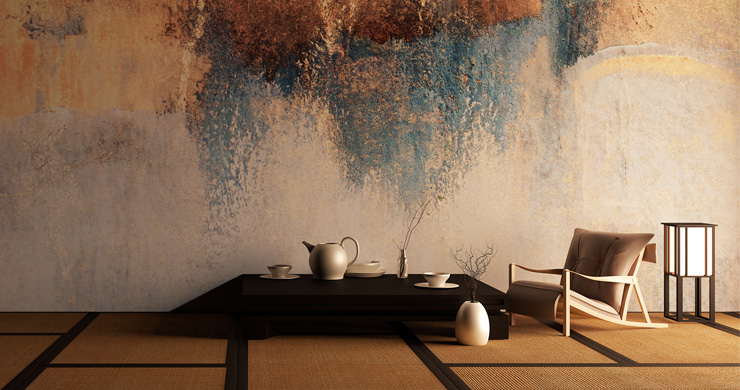
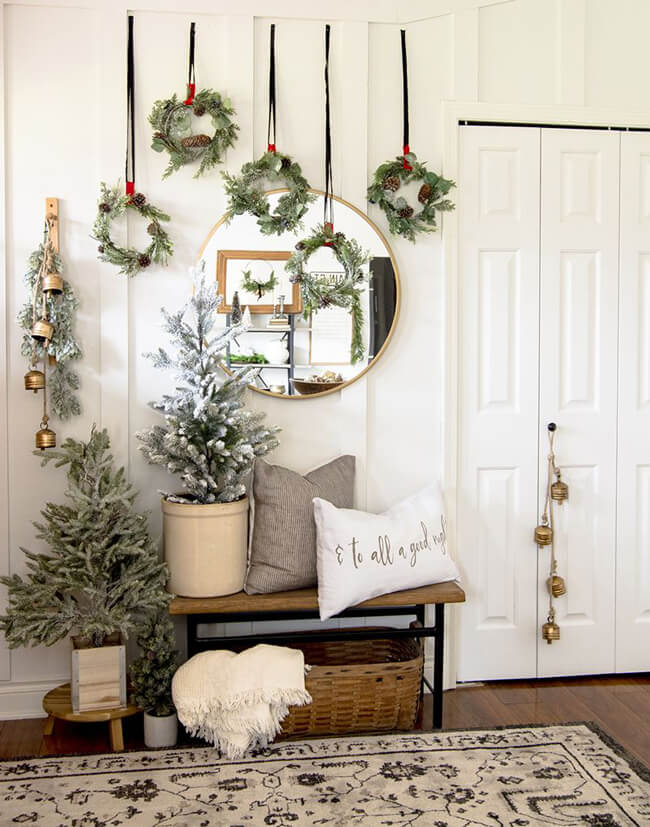
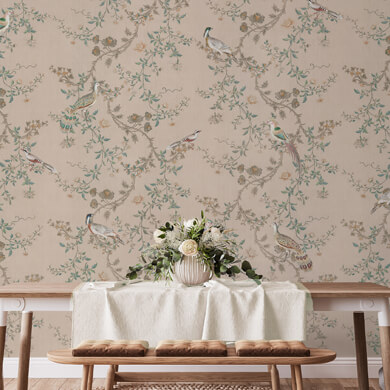
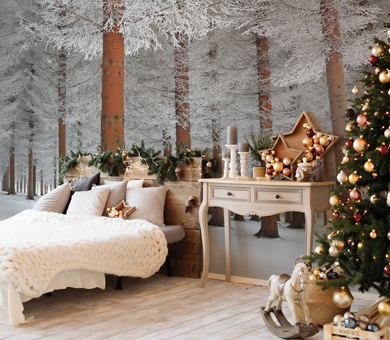
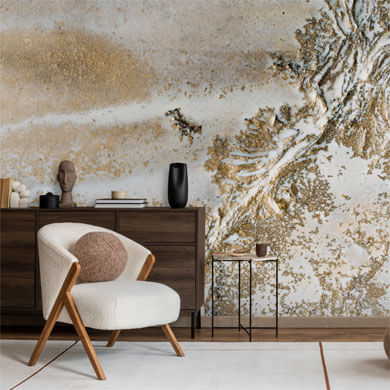
N.M
21/02/2022Thank u for this beautiful information. We look forward to more information.
Amy @ Wallsauce
21/02/2022Hello N.M! Thank you for your comment. Please keep visiting our blog page for more information.
David
23/12/2022Interested in decorating my apartment Japanese style
Rachael @ Wallsauce
23/12/2022Hello David, the Japanese style is a beautiful interior style and if you require more inspiration, here is a link to our Japandi Style blog article which you may find helpful - https://www.wallsauce.com/blog/what-is-japandi-style
Mathiyazhagan
06/06/2023Great article. I really loved it.
Amy @ Wallsauce
06/06/2023Hello Mathiyazhagan! We're so happy you liked this article! Don't forget to check out our other blog posts!
Angel
12/12/2023What a great article ! After studying many different designs and years that a particular interior design was popular ,. I think we\'ve studied this for nearly two years I am a little more of a maxamalist then a minalmaist I still those this design will wonderfully for our family ! I think Japanese design is beautiful !